If I had to pick one word to sum up Expeditions: Rome, in comparison to other RPGs but especially its own predecessors, it would be “streamlined”. It’s remarkable how much of the standard RPG cruft it sands away, and how many of the Expeditions-specific survival mechanics have been bodily thrown out of the window. This streamlining gives it room to do a few things, particularly in the realm of its turn-based tactical combat, that are borderline inspired. At the same time, though, the streamlining is somehow both very aggressive and not aggressive enough; there’s more than a few systems and mechanics here that have been streamlined so much that what remains is basically vestigial, and should have been cut from the game entirely.
The end result is a game that simultaneously feels overly bloated — Expeditions: Rome took me a whopping 37 hours to finish, compared to 25 for Expeditions: Viking — and yet curiously empty. In many places what remains after the streamlining is so simple it doesn’t stand a chance of engaging the brain, and so every time a random travel event pops up or a food meter starts to get low the reaction is one of profound exasperation because there’s very little that you can functionally do to avoid or ameliorate it. 37 hours of batting away these dialogues, of having to deal with these atrophied mechanics that feel like so much make-work, did a lot to sour my initially-quite-positive opinion of Expeditions: Rome. Which is a shame, because in terms of design and production values it’s the best game in the Expeditions series by some considerable distance and would have had a decent chance of standing up against other AA-tier RPGs — Wasteland 3, Pillars of Eternity 2, that kind of thing. Actually no, Rome is just straight-up a better game than Wasteland 3 in spite of its issues; what I’m trying to say here is that it could have given the very best games operating in this space a run for their money if Logic Artists had been a bit more ruthless about what they should and shouldn’t cut, and a bit more sensible about player quality-of-life features.
But there’ll be plenty of time to get into that. First, the standard one-paragraph explanation of Expeditions: Rome’s premise, which is quite explicitly an alternate-history retelling of the events immediately preceding the transition of the Roman Republic into the Roman Empire. You play the son/daughter of a patrician family who is secretly hustled out of Rome for extremely poorly-explained reasons and put on a ship to Asia Minor (modern-day Turkey) to join the legions who are trying to subdue rebellious provinces and a Parthian invasion. You are joined on this ship by your major NPC party companions, as well as a young Julius Caesar at the very beginning of his military career — which is prematurely cut short when he gets killed less than an hour into the game, allowing you to step into his shoes. You pretty quickly get command of the entire legion (which stretches historical plausibility more than a little and breaks it entirely if you’re playing a female character; from what I’ve seen Expeditions: Rome is very aware of how patriarchal Roman society was and heavily lampshades the fact that having a woman in any position of authority would never have happened in the real Republic, but this somehow makes it worse than if they never mentioned it at all), and from then on the game is split into two parts: ordering your legion around the world map to fight enemy armies and capture cities, while you yourself take command of a small band of Roman special forces to do the more traditional party-based RPG stuff.
The legion battle mechanic is the most unusual thing this game does, so let’s tackle that first. It is, unfortunately, extremely basic, and while it does make more than a token effort to try and convince me it’s more than just comparing two numbers — your legion strength, and the enemy army strength — and having a random number generator periodically reduce one or the other, it’s also massively overused to the point where I felt compelled to skip through all of the flavour trappings to save time and just ended up dealing with the numbers anyway. The idea is that there’s three factors that go into your legion strength rating: number of men in the legion, legion veterancy, and legion morale. The game sets that strength rating against the enemy army’s, runs through a series of automatic and generic Attack/Defend events that you can’t do anything to affect and which will reduce one side’s strength by a small amount, and then three times per battle allows you to choose one of three Tactics cards which are the only input you have into the battle’s outcome. These cards are randomly chosen and have effects like reducing the chance your commander will die (useless, because I never saw a battle that had more than a 2.5% chance of killing him), reducing the number of killed/missing legionaries at the end of the game (useless because of the way the game handles manpower), or reducing the enemy army’s strength either directly via attacking their manpower, or by tanking their morale. This last category are always instant picks because the way the game determines who actually wins the battle is very simple: the army with the highest strength wins.
Now, as I said Expeditions: Rome did try and convince me that the legion battles had more going on than this. In fact I spent most of Asia Minor — the story also takes you to Egypt and Gaul — trying to figure out why none of these levers the game gave me to influence legion battles actually seemed to be doing anything. Legion veterancy fluctuated up and down randomly regardless of whether I won a crushing victory with no losses or took two-to-one casualties. Legion size had no effect on how many kills I inflicted or legionaries I lost; going in with an army four times the size of the enemy would still cause me to lose 600 men while only killing 200 in return, which made no sense. You can pick which one of your centurions you want to command the legion at the start of the battle which will cause it to fare better or worse in the generic Attack/Defend events based on the centurion’s traits – but since there’s no way of knowing which traits will be good ahead of time, and since there’s no additional benefit to a specific trait beyond it countering one of these specific events, you just always pick the centurion with the most traits unlocked so that you can counter the biggest range of events possible. In short, aside from the Tactics cards there’s nothing substantial that you can do to influence the outcome of a battle because it’s all determined purely by RNG dice rolls — that and your starting army strength.
It’s here that we come to the particularly stupid thing about Expeditions: Rome’s legion battles. As stated, army strength is the total of your legion manpower, veterancy and morale values all added together. Manpower is just a straight 1:1 conversion into strength, and veterancy and morale get a 10x multiplier (so a legion with 50 morale gets +500 to its strength), but manpower is still the biggest contributor to army strength despite this. Legions have a manpower cap of 4,800 men, and while you’ll obviously take losses in battle and have some number of legionaries out of action thanks to being wounded, it’s always possible to be operating at the nominal manpower cap because you can just go to the Barracks in your legion camp and buy more men. The only limiting factor is having enough money to do so, which isn’t a limiting factor at all because 1) you can trade excess food and medical supplies for money, and the game throws far too much of both of these resources at you, and 2) thanks to the aggressive streamlining there’s literally nothing else you can do with your money in this game (you craft weapons and equipment for your party rather than buying it) aside from handing out bribes whenever a special conversation option comes up.
Functionally, then, if you’re keeping your manpower up your minimum army strength going into a battle is going to be around that manpower cap of 4,800, and the reason this is dumb is because a typical enemy army in Asia Minor has an army strength of 1,200. Even the endgame armies in Gaul aren’t much stronger than 3,000. And since the game keeps the scale of casualties inflicted and losses sustained quite low, on the order of a few hundred points of army strength per battle (presumably to keep you from accidentally having your legion wiped out in one go thanks to bad RNG) and since the winner of the battle is determined by who has the biggest army strength at the end, there’s no mathematical way for an army of 4,800 men to actually lose a fight against any of the enemy armies Expeditions: Rome throws at you. And let me restate: boosting your legion up to 4,800 men is not an endgame thing. It’s actually possible in hour three of the game (which is when you get the legion in the first place) if you do a few legion missions to get food, trade it for money, and then use that money to boost your legion up to the manpower cap. Once you’re there you will never drop much below the manpower cap again, and that’s legion battles rendered totally irrelevant for the next 34 hours.
Legion battles are an unusual example of how basic a lot of Rome’s mechanics feel because it does have a bunch of superficial things tacked on to it (morale, veterancy, centurions, a laughably bad loot mechanic) that initially make it seem more complicated than it is. However, once you realise it just boils down to “is number bigger than other number” you’ll see it fits in quite well with everything in Expeditions: Rome that isn’t the story or the tactical battles. In my Viking review I complained that the survival mechanics around camping and injuries took too much effort to figure out for too little effect and could have just as easily been replaced with a big “REST” button. Here that’s a criticism that still does very much apply to the legion battles, but the survival and injury mechanics have been excised from the game almost completely. Food is now just a meter that you keep topped up and which inflicts big debuffs on your party if you ever let it drop to zero, and injuries do still need to be treated by somebody in your party (and also inflict big debuffs while they’re healing) but they’re very much just set-and-forget: pick somebody to treat the wound in the Triage screen, and then just wait a day or two while your medical supplies tick down. My question here, though, is why am I even having to do this amount of thinking about it? I’ve spoken about my hatred of food/hunger meters in survival games before, but even discounting that, what exactly is it adding to the game to have to occasionally do a couple of minutes of clicking to make sure my food is topped up, or have to wait around for 3 days of in-game time for an injury to heal so that I can avoid the injury debuff?
To say I found this grating would be a significant understatement. The Expeditions series survival mechanics were never particularly interesting to begin with, but their incarnation in Rome is now just pure make-work; there’s nothing to be gained from skilful management of anything they offer, partly because they’re so simple and partly because they’re entirely focused around the negative design principle of having to engage with the system in order to avoid penalties, rather than granting bonuses or buffs for doing it right. This makes Rome’s random encounters even more of a fuck-you than they would be otherwise; mercifully they’re almost entirely text-based and only very rarely suck away even more of your time by loading up a tactical battle, but said text-based events are very Oregon Trail, usually running along the lines of “One of your party falls off their horse and sprains their ankle, -30% movement until they’re healed” with, again, nothing you can do to avoid or mitigate this. This isn’t interesting. These systems and mechanics don’t offer anything to the player, and it’s largely thanks to them that I really, really grew to resent the portions of Rome that took place on the world map.
Fortunately for Expeditions: Rome this is only about a third of the game. “A third” in this case still amounts to about 12 hours, and not coincidentally the world map is probably the major (although by no means the only) contributor to the game feeling like it’s about 12 hours too long, but the bulk of the rest of it is taken up with the story and the tactical combat segments which I’m happy to say I’m a lot more positive about. The tactical combat is an evolution of what we saw in Viking; turn-based combat on a hex grid, with a heavy focus on use of activated abilities and environmental features over RNG dice rolls. Rome isn’t quite the perfect, predictable beast that the genre of XCOM-alikes seem to be evolving towards, but it’s close, with most attack abilities having a base to-hit chance of either 100%, or 0%. The latter are usually encountered by archers who are trying to shoot enemies who are hiding behind cover, or behind a big Roman tower shield, and in that event it doesn’t faff around with any edge case scenarios like having a 17% chance of maybe being able to hit an exposed toe; if an enemy is in cover you’re just not going to hit them, period, and you need to take active steps to remove the cover by driving them out of it or by moving to a better position.
Melee attackers have a different problem: their attacks will always hit unless the attacker is blinded or the target is in a dodge stance, but that attack will then have to get through three layers of defence in order to cause any damage. First up is a defender’s shield, if they’re holding one; shields are an additional ablative pool of HP that absorb any melee hits, and it’s only when the shield HP is fully depleted that you can start to hit the person holding it. Shield HP regenerates at the start of every round of combat, and while this regeneration buff will fall off the more you hit the shield it’s not really practical to try to wear down a shielded enemy with basic melee attacks alone because they can and will hold you up for multiple rounds of combat. There’s a few steps you can take to nullify the shield, ranging from smart use of shield-breaking abilities to simple weight of numbers, but you need to do something to get rid of it. Once it’s gone you then have to deal with their armour rating, which works very simply: an enemy’s armour value is deducted from all incoming physical damage with only the remainder making it through to the target, and so if a target is particularly heavily-armoured then an attack will do no damage at all as it’ll all be soaked up by the armour. To counter armour you need to either use certain weapons and abilities that ignore it, or else employ the services of a spear-wielder who can apply the Armour Shred effect with every attack, permanently reducing the target’s armour. Finally, once you’re through the armour you need to deal with their damage resistance; a target with 30% Slashing damage resistance has a 30% chance of converting any incoming Slashing attack to a Glancing hit that only does 1-2 points of damage. This is the one part of the tactical combat where you can take your chances with the RNG if you want, but it’s better to turn the odds in your favour by either swapping to a weapon with a damage type that the target is weak against — there are very few enemies in the game that have high resistances against Slashing, Piercing and Crushing attacks — or else by flanking them with another party member, which reduces all of their resistances to zero.
That’s a lot of defensive barriers to get through before you can kill somebody, and it’s true that some enemies in Rome have the same approximate level of toughness as one of the giant robots from Battletech. You can see that every single one has multiple counters, though, and that’s just with the basic combat moveset — once you get into character skills, weapon abilities and special items the decision you have to make in combat is which method you’re going to use to kill somebody rather than how you’re going to do it in the first place, or whether you’ll be able to do it at all if a bad RNG roll screws you over. This is a much more interesting prospect, especially since there’s also a sequencing element to it; your party members only get one action point per round with which to make an attack, but Rome has the concept of a “militia” enemy who is noticeably weaker than the proper ones and is there to bulk out the enemy ranks, and if you kill one of these chaff enemies you get an action point back. If you use the right skills to chain militia kills you can have a single character chew through three or four enemies in a single round, which is very important when many of the encounters you get thrown into feature enemy forces that outnumber you more than three-to-one.
This is nowhere near as obnoxious as it sounds. For starters, a large percentage of those enemy forces will be those weak militia enemies, who can be moderately annoying if left alone to do things like throw torches at you (fire attacks are devastating if not put out immediately) but are actually a benefit to you if they’re dealt with promptly because murdering them will inflict morale penalties on their bigger, tougher friends. Expeditions: Rome is also surprisingly good at providing a decent variety of combat objectives beyond “kill all of the enemies”, whether that’s to destroy supplies bound for an enemy camp or rescue a local chieftain who is sympathetic to your cause. Outside of the game’s set-piece sieges none of them are particularly imaginative, but it’s definitely nice to play a game that isn’t hell-bent on having me slaughter the entire population of Gaul one at a time and it does prompt some variety in the tactics you use. You don’t get XP from killing enemies and while you can loot their corpses after the battle almost all of the equipment you’ll get from them is worthless past the early game — Expeditions Rome instead has you relying on a mix of quest reward items and crafted gear which will be an order of magnitude better than anything you’ll pull off of an enemy corpse — so there’s absolutely no reason not to play to the objective and end the battle ASAP before you get overwhelmed.
So the tactical combat, aside from having a few weaknesses in the areas where it interfaces with other game systems (like the semi-randomised weapon abilities, which seem to be there mostly to encourage you to craft a sword over and over again until you get a complimentary set of attack abilities out of it), is extremely solid. I was never unhappy to enter one of Expeditions Rome’s tactical battles; they’re a little limp at the start of the game when you don’t have any abilities or special items to turn the tide in your favour, but past hour four or five the possibilities really start to open up. Thanks to the objective variety and the fact that every encounter is scripted rather than procedurally-generated, it even manages to stave off the classic XCOM problem of growing stale and repetitive for far longer than I thought it would be able to given the number of tactical combats you fight during the course of the campaign. And I should mention in passing that I was also very impressed with Rome’s character skill trees, which seemed underwhelming at first because they focused on giving you more tools to get through a battle, not better ones, so there wasn’t any obvious power progression. However, when multiple characters combine their skills together, or when you have certain weapon traits in the mix, you can still create some obscene combos; it doesn’t matter if you’re outnumbered three to one when the entire enemy force is either flat on their asses thanks to a knockdown, gibbering in the corner because they’ve had their morale destroyed, standing in the middle of a raging inferno, or stuck in a position where an archer will one-shot them with a boosted overwatch ability if they move. Where Expeditions: Rome’s world map is starved of interesting decisions to make, the tactical combat side of the game is seemingly nothing but.
I think it’s the story that’ll make or break Expeditions: Rome for most people, though, and while I wouldn’t have sat through 37 hours of this game if there wasn’t something there, narratively speaking the story is a very qualified success. The game is split into three chapters, one for each of Asia Minor, Egypt and Gaul, and the narrative drive for this globe-trotting is because there’s an evil Roman senator who keeps plotting against your family for extremely poorly-defined reasons and whose schemes require you to travel to these various regions of the world in order to get to the bottom of; the mass slaughter and eventual conquering of the locals is a mere byproduct of this petty personal squabble. The villain is terribly written, disappearing for large portions of the game and only reappearing to remind you that he exists in the intermissions between each chapter where you go back to Rome to get a read on the political situation there; the game tries to pass him off as always being one step ahead of you because he’s an experienced senator who is very familiar with the Roman political system, but it shows you literally nothing to support this and the only way to explain some of his actions are because he’s read the script for the game in advance. Because he’s absent for most of the game and barely characterised for the parts where he’s present, there’s not really any coherent through-line for Expeditions: Rome’s story and it’s essentially just three unrelated mini-campaigns with a denouement at the end where you can do a proper Julius Caesar if you want1.
No, outside of those final hours, when the story belatedly rouses itself from its stupor and comes surprisingly close to delivering a fitting finale (if you pick the choices I did, anyway), I don’t think I could say Rome’s core narrative is any good. I didn’t care about the villain or my family’s beef with his family at any point. But the game did succeed in dragging me through 37 hours of not-entirely-fun gameplay, and that it held my interest for this long is mostly down to two things that are story-adjacent: the production values, and the opportunity to do some fun historical tourism. The game is littered with famous characters like Cato, Cicero and Cleopatra, but its attention to historical detail goes a lot deeper than just appealing to anyone who’s seen both series of HBO’s Rome and it’s fun to see its alt-history take on the period play out. If, like me, you’re the sort of person who drags themselves through Assassin’s Creed after Assassin’s Creed2 purely because you like wallowing in the history, then you’ll probably like the historically-flavoursome mini-narrative that unfolds in each individual campaign in spite of the overall shortcomings of the meta-narrative.
Then there’s those production values, which are a good example of resources being spent in the places where they can do the most good. While it’s a perfectly serviceable thing in terms of pure looks there are certain parts of Expeditions: Rome, such as the character animations and a few wonky interface issues, that periodically remind you that it’s coming from a smaller studio that struggles to match even the AA-tier RPGs from likes of Obsidian and inXile. Most of the time it does a good job of making you forget this, though; the character writing, while not outstanding, is good enough that you do grow attached to the named NPCs in your party, and this is aided by some excellently detailed head-and-torso portaits of most characters in the game that pop up whenever you enter a dialogue with them. I’ve maintained for years that investing in some good static 2D art assets is the best approach you can take if you’re seeking to build a sense of place and character but don’t have much budget to throw at the problem, and Expeditions: Rome really bears that out. And, as is now standard for modern RPGs3, the dialogue is (almost) fully voiced. Again, as with a lot of things about Rome this voice acting is competent rather than outstanding, but I’ve played a few too many games with actually bad voice acting recently to complain about this; it’s good enough to enhance an otherwise drab story by its mere presence in the game, which is all I can really ask for from voice acting.
So, “streamlined” is indeed a word that has come up several times in this review. So have the words “competent” and “serviceable” and “good enough”, but while I feel this is fairly descriptive of the bulk of Expeditions: Rome it’s also damning it with faint praise. I really wish I could reach for a higher grade of superlative because I genuinely did enjoy a lot of what it was doing, but its shortcomings hold it back; in spite of the streamlining you could still outright cut a lot of the world map content from the game completely and the result would be a leaner, healthier game that didn’t continue for around eight or nine hours past the point where it had thoroughly outstayed its welcome. Fatigue was definitely starting to set in during the final third of the story, and I needed to take a break for a couple of days before mustering up the fortitude to power through to the end. That’s a considerable black mark against an otherwise good game, and the main thing stopping me from recommending Expeditions: Rome as a stopgap while we’re in this comparatively fallow period for traditional CRPGs.
——————————————
A short postscript, because I couldn’t figure out a good place to mention this in the main body of the review despite it definitely being worth mentioning: Expeditions developer Logic Artists are closing down so that the staff can join a new studio focused around the development of NFT games, which is possibly the dumbest piece of gaming news I’ll read all year.
- The “becoming dictator for life” part, not the “being stabbed to death in the senate chamber” part. ↩
- Fortunately Valhalla has broken the spell and I think I’m done with the series now. ↩
- I’ve got to say I’m slightly annoyed by this trend. Having your game be fully voiced does help to draw the player into the world you’re creating, but it’s expensive and time-consuming to do if you’re an indie studio and also constrains the development process, as any dialogue that’s voiced is impossible to rewrite later. The reason this is now the standard approach for RPGs isn’t because of the benefits voiced dialogue bring to the game, but rather because 1) console ports are more common these days and you can’t ask somebody to read tiny text on a TV on the other side of the room, and 2) to appeal to Twitch streamers, who are allergic to reading. ↩

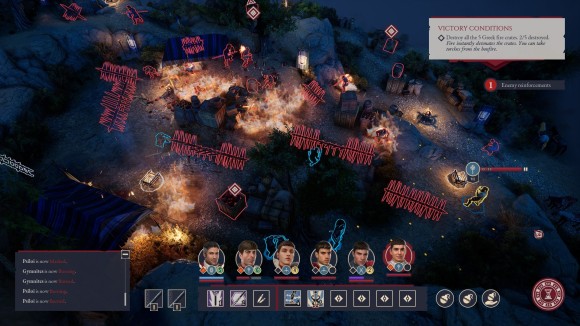
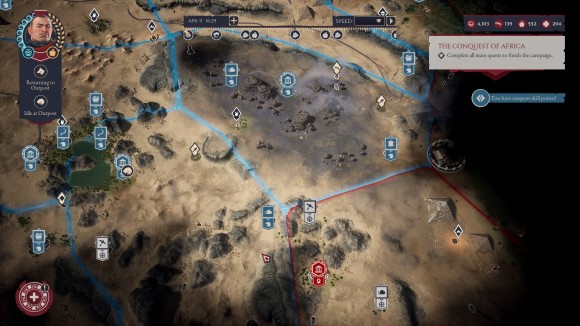
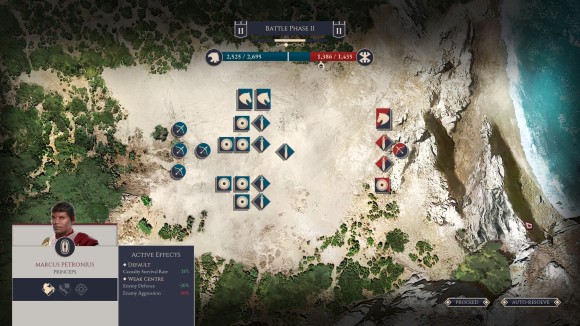
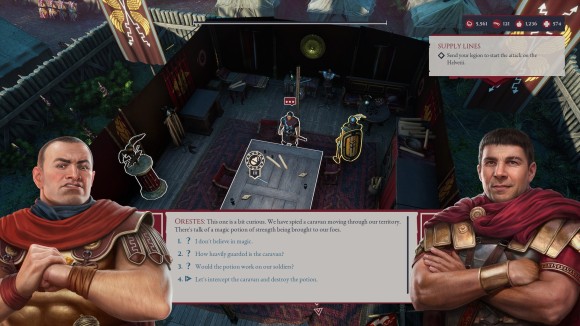
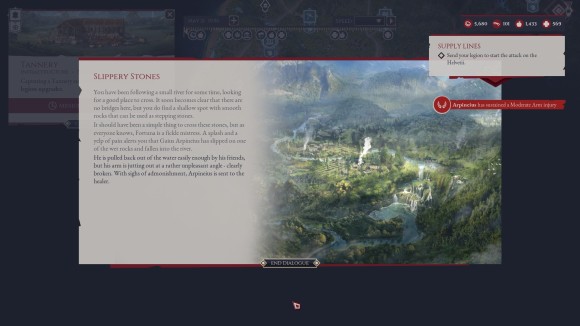
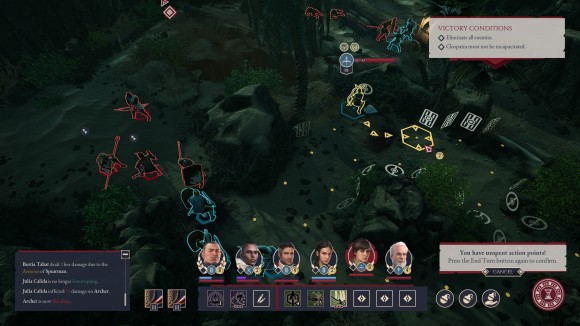
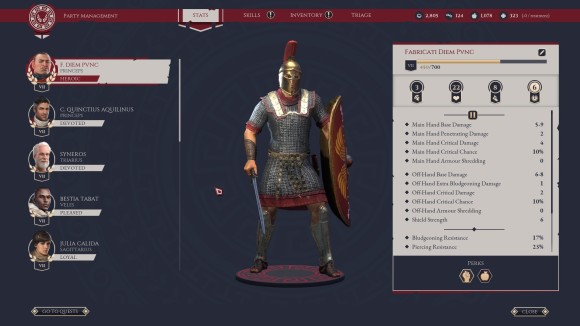
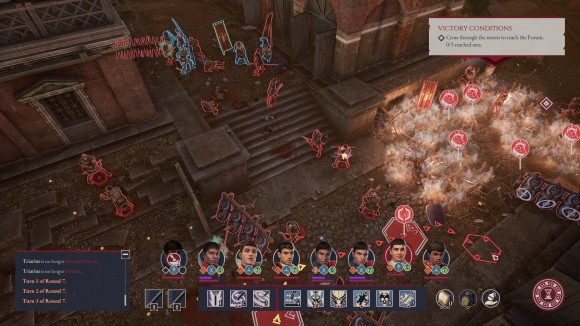
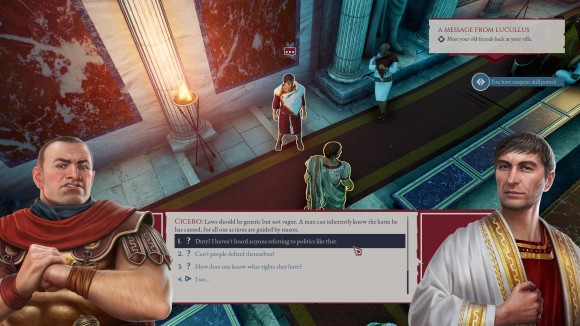
I’ve played Expedition Vikings just recently. I liked its approach to history (I think it did a good job highlighting ahistorical concessions to gameplay or story. Certainly a lot better than Assassins Creed Valhalla that basically has the same plot) and tactical battles. But I agree with you about the abundance of incohesive mechanics. Whole survival aspect interacts with the time limit, but that time limit is extremely generous. Very rarely you have to fight a series of battles and injury system comes in place, and I don’t think my people ever fought while starving or exhausted. There are defended resting places that are probably supposed to give you unique opportunity for a small battle when your party is not at full strength, but you can just walk few hours more and sleep there, it’s a no-brainer. Especially with the game having a little too many tactical fights already. Many of them had unique maps or challenges but there was enough generic ones too. It’s always sad when complex looking systems turn out to be a puzzle you solve once and then it’s busywork.
I also think that tactical gameplay was good but suffered from classless system allowing to make characters that are just a little too perfect. Glad to hear Rome has class system. You sold me this game even if strategic map mechanics do not sound interesting.
And yes, full voice acting is a plague of RPGs. Pillars of Eternity 1 (2 tries to pretend it has full VA but has a lot of book interactions that have no VA) or Pathfinder is the best approach really, make VA for the most important scenes, give it to important characters. Don’t set script in stone months before release or force an actor to invent a new voice for unnamed peasant #24.
That review ending is M. Night Shyamalan level shit.
I have not really enjoyed the Expeditions games much, but always appreciated the effort the devs made to keep me entertained for a few hours.
The news of them leaving relatively niche PC CRPGs for NFT “games” was a bit like wtf. If they were looking for jobs that paid mortgages there are better lines of work…